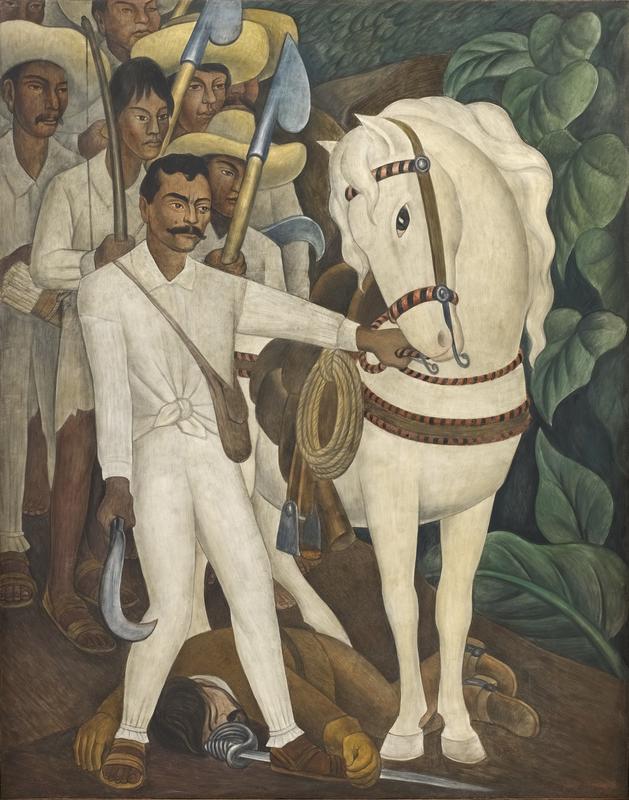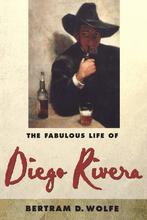More about Agrarian Leader Zapata
- All
- Info
- Shop

Contributor
It’s New York, 1931, and one of your buddies mentions that Diego Rivera is in town at the MoMA. All you wanna do is get hammered... But you can’t because prohibition is still a thing.
Rivera’s supposed to be some art hotshot though, so maybe you’ll drop some dough on a painting. But when you get to the museum, you’re appalled and insulted. These paintings are… political?! One painting in particular, Agrarian Leader Zapata, makes your stomach turn. Peasants aren't supposed to be overthrowing urbanites. A city dweller like yourself has never been more offended. This dude needs to stay in his lane. Okay, it’s not 1931, and you’re probably drunk while reading this because prohibition ended a long time ago. But that jarring reaction to Rivera’s work was more common than you’d think in his time. When his exhibition opened to the public, it was only the MoMA’s second show for a living artist. The first being Henri Matisse. So naturally, art aficionados were hype. Rivera was regarded as one of the illest artists of his time. Imagine Banksy showing up to your niece’s birthday. It was that level of awesomeness.
Rivera was radical about his politics, and that was prevalent in his work. That’s why a painting depicting Mexican revolutionary Emiliano Zapata as a hero of the people could have caught so many off guard. Zapata physically fought his government for fair and equal treatment, and died because of it. Because Rivera never shied away from expressing personal political views in his art, the dynamic between his work and those who paid to produce and view it grew fragile. It’s not too different from the division we’re facing today with athletes, fans, and corporations. In 2018, people are burning Nikes because the company is in solidarity with an athlete who kneels during the national anthem in protest to police brutality.
Rivera stans willfully neglect to mention that the paintings at the 1931 exhibition were not his best work. They were quickly made and they were portable, which showed Rivera’s mad genius level ingenuity, and ability to adapt. What’s interesting, however, is that these paintings spoke to a very specific type of fan base of Rivera’s who held him on such a pedestal, it was almost as if he could do no wrong. They appreciated the free form aspect of its process, and hailed the innovative measures used to construct it. It’s like when Kanye split his supporters down the middle by openly supporting Donald Trump. A lot of people jumped off the train. But some still showed up when he dropped “Poop di Scoop” a few weeks later, quoting its brainless bars while claiming he’s a genius.
Whether it’s 1931, 2018, or when you’re reading this in 2043, I think it’s safe to say that Diego Rivera was an artist who refused to be put in the box that others placed him in. Whether you lean left or right, you can’t limit an artist’s vision.
Sources
- Abad-Santos, Alex. “Why the Social Media Boycott Over Colin Kaepernick is a Win for Nike.” Vox. September 6, 2018. Accessed September 6, 2018. https://www.vox.com/2018/9/4/17818148/nike-boycott-kaepernick
- Biography Channel. “Emiliano Zapata Biography.” Accessed September 6, 2018. https://www.biography.com/people/emiliano-zapata-9540356.
- MoMA. “Diego Rivera: Murals for The Museum of Modern Art.” Accessed September 6, 2018. https://www.moma.org/calendar/exhibitions/1152?locale=en
- Schjeldahl, Peter. “The Painting On The Wall.” The New Yorker. November, 28, 2011. https://www.newyorker.com/magazine/2011/11/28/the-painting-on-the-wall
- Roberts, Jodi. “Diego Rivera: How to Make a Portable Mural.” February 1, 2012. Accessed September 6, 2018. https://www.moma.org/explore/inside_out/2012/02/01/diego-rivera-how-to-…
- Rosenberg, Karen. “Time Capsule With Pulse on Present.” New York Times, November 17, 2011. https://nyti.ms/2ltIBQF.

Contributor
Diego Rivera's Zapata marks a profound shift in the self-identity of the Mexican people, for whom it served as a lesson in the possibilities of organizing.
Zapata was instrumental in teaching contemporary Mexicans about the revolutionary Emiliano Zapata's relevance to their lives. The Mexican Revolution lasted nearly ten years, and the armed phase ended with a new constitution the same year as the communist revolution in Russia, in 1917. Zapata's home state of Morelos, which Rivera visited for some hands-on revolutionary research, had almost no industry, and almost everyone tilled the soil by hand for subsistence. Zapata was not a subsistence laborer himself, but he led the people to victory in their demands for land reform, which were opposed by monopolies of landowners and politicians in cahoots, from Mexico City to Washington. Zapata's bravery and heroism, which his followers, the Zapatistas, called Zapatismo, was completely distinct, and much more strategically specific, than Diego Rivera's Marxismo, but the intellectually ambitious Rivera managed to fit it into his expansive communist theory of everything.
Rivera was essential in giving credibility to the Museum of Modern Art, and, just two years after its opening, he debuted this work in their gallery, breaking attendance records with 56,575 attendees, more than twice the number that attended a prior Matisse show. He'd innovated the use of the mural form, based on his studies of Italian art, for political education in Mexico, which was an enormously successful strategy. This work is a sample from a larger fresco he'd done one year earlier at the Palace of Cortés, Cuernavaca. Members of the concrete, iron, and steel mural series weighed up to half a ton—they called them "portable" only because they're easier to ship than an entire building. "As the fresco dried, the lime in the mortar reacted with the air to create a hard layer of calcium carbonate. This chemical reaction effectively fused the pigments to the work’s surface." They couldn't expect people to fit "portable murals" in their homes, so they also printed affordable lithographs, redrawn by Rivera, of five of the murals with the George C. Miller print shop and Weyhe Gallery, which had an enormous impact.
Zapata wears the customary clothing of Cuernavaca, and he's commandeered the Man's white horse, modeled from the work of the Florentine painter Uccello, for the revolution. Rivera commandeered Zapata's legacy for communism, but Zapata might have appreciated him for doing it. There's no way to know.
Like many revolutionaries, Zapata was betrayed and martyred by another revolutionary faction. Two years later, Rivera returned to Mexico from his Renaissance studies in Europe. Six years before this painting, Rivera had attended a ceremony at Zapata's grave site, at which the Mexican government declared its allegiance to Zapata's principles. By the time he produced this work, Rivera was in the Communist doghouse: the Mexican government had outlawed the Communist Party two years earlier, and he had already become a pariah to other Communists for his affiliation with Trotsky, who led a faction that seemed to be less violent than that of Stalin, which isn't saying much. Rivera's work, like Frida Kahlo's, shows that for artists from countries struggling against the greed and exploitation of colonialism, Marxism often seemed necessary. The difficulty was, and still is, that the obligatory, dogmatic atheism and materialism of the ideology goes against the indigenous faith practices of nearly everybody everywhere, if not the feelings of Marx himself. Marx had no idea what kind of can of worms he was opening, although some of those worms have surely helped people to overthrow tyrannical colonial viceroys. By reducing everything to material value, communism threatens to remove the soul from the righteous project of helping out the poor. By enforcing the idea of fulfilling everyone's economic needs with a one-size-fits-all formula, communism was often too mechanical, and too hostile toward local faiths. Rivera stepped up to the plate as an artist who could bridge the PR gap between the Russian atheist agenda and more humble indigenous lifestyles. Still, the lives of farmers were quite different from those of the workers in Marx's London: their lives were based on the cycles of the seasons, not the timecard.
In the same year, Rivera had produced his masterful Allegory of California for the San Francisco Stock Exchange, and the next year he made his epoch-making Making of a Fresco, Showing the Building of a City at SFAI. Each image, while aesthetically marvelous, is a lesson and a reminder to the hoity-toity and the captains of industry that their caca also smells like caca.
Sources
- Bee, Harriet Schoenholz, Cassandra Heliczer, and Sarah McFadden. MoMA Highlights: 350 Works from The Museum of Modern Art, New York. New York: Museum of Modern Art, 2013.
- Blanco, Hugo. We the Indians: The Indigenous Peoples of Peru and the Struggle for Land. Talgarth, Wales: Merlin, 2018.
- Dickerman, Leah, and Anna Indych-López. Diego Rivera: Murals for the Museum of Modern Art. New York: MoMA, 2011.
- Foard, Sheila Wood. Diego Rivera. Philadelphia: Chelsea House, 2003.
- Gonzales, Doreen. Diego Rivera: His Art, His Life. Berkeley Heights, NJ: Enslow, 2006.
- Hurlburt, Laurance P. The Mexican Muralists in the United States. Albuquerque: University of New Mexico Press, 1989.
- Ittmann, John W. Mexico and Modern Printmaking: A Revolution in the Graphic Arts, 1920 to 1950. Philadelphia: Philadelphia Museum of Art, 2006.
- Kettenmann, Andrea. Diego Rivera, 1886-1957: Un Esprit Révolutionnaire Dans L'art Moderne. Köln: Taschen, 2000.
- Marten, James. Children and War: A Historical Anthology. New York: NYU Press, 2002.
- Roberts, Jodi. "Diego Rivera: How to Make a Portable Mural." MoMA, Feb. 1, 2012, https://www.moma.org/explore/inside_out/2012/02/01/diego-rivera-how-to-….
- Snodgrass, Michael. Deference and Defiance in Monterrey: Workers, Paternalism, and Revolution in Mexico, 1890–1950. Cambridge: Cambridge University Press, 2003.












